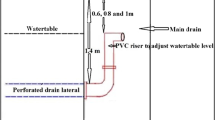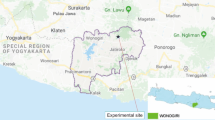Abstract
A 4-year field experiment was conducted in a semi-arid area to evaluate the response of each furrow and alternate furrow irrigation in wheat-cotton system using irrigation waters of different qualities in a calcareous soil. Irrigation was applied to each and alternate furrow of bed-planted wheat followed by ridge-planted cotton for comparison with standard check-basin method of irrigation to both the crops. These methods of irrigation were evaluated under three water qualities namely good quality canal water (CW), poor quality tube well water (TW) and pre-sowing irrigation to each crop with CW and all subsequent irrigations with TW (CWpsi + TW). The pooled results over 4 years revealed that wheat grain yield was not affected significantly with quality of irrigation water, but significant yield reduction was observed in alternate bed irrigation under canal water and tube well water irrigations. In cotton, poor quality tube well water significantly reduced the seed cotton yield in all the three methods of planting. The pre-sowing irrigation with canal water and all subsequent irrigations with tube well water improved the seed cotton yield when compared with tube well water alone. However, this yield increase was significant only in alternate furrow irrigation, and the yield obtained was on a par with yield under alternate furrow in CW. When compared to check-basin irrigation, each furrow and alternate furrow irrigation resulted in a saving of 30 and 49% of irrigation water in bed-planted wheat, whereas the corresponding savings in ridge-planted cotton were 20 and 42%, respectively. Reduced use of irrigation water under alternate furrow, without any significant reduction in yield, resulted in 28.1, 23.9 and 43.2% higher water use efficiency in wheat under CW, TW and CWpsi + TW, respectively. The corresponding increase under cotton was 8.2, 2.1 and 19.5%. The implementation of alternate furrow irrigation improved the water use efficiency without any loss in yield, thus reduced use of irrigation water especially under poor quality irrigation water with pre-sowing irrigation with canal water reduced the deteriorating effects on yield and soil under these calcareous soils.
Similar content being viewed by others
Notes
Irrigation water that is not being used is only ‘saved’ if there are viable options for its use elsewhere i.e. does not drain away from the fields or percolates to saline groundwater.
References
Aujla MS, Thind HS, Buttar GS (2007) Fruit yield and water use efficiency of eggplant (Solanum melongema L.) as influenced by different quantities of nitrogen and water applied through drip and furrow irrigation. Sci Hortic 112:142–148
Aujla MS, Thind HS, Buttar GS (2008) Response of normally sown and paired sown cotton to various quantities of water applied through drip system. Irri Sci 26:357–366
Boumans JH, van Hoorn JW, Kruseman GP, Tanwar BS (1988) Water table control, reuse and disposal of drainage water in Haryana. Agric Water Manage 14:537–545
Buttar GS, Thind HS, Aujla MS (2006) Methods of planting and irrigation at various levels of nitrogen affect the seed yield and water use efficiency in transplanted oilseed rape (Brassica napus L.). Agric Water Manage 85:253–260
Choudhary OP (2003) Management of poor quality waters for rice-wheat cropping system. In: Yadvinder-Singh et al (eds) Nutrient management for sustainable rice-wheat cropping system. National Agric Tech Project, Indian Council of Agricultural Research, New Delhi, pp 330–343
Choudhary OP, Guman BS (2008) Cyclic use of sodic and non-sodic canal waters for irrigation in cotton-wheat cropping system in semi-arid region. J Sustainable Agric 32:269–286
Choudhary OP, Josan AS, Bajwa MS, Kapur ML (2004) Effect of sustained sodic and saline-sodic irrigations and application of gypsum and farmyard manure on yield and quality of sugarcane under semi-arid conditions. Field Crops Res 87:103–116
Choudhary OP, Guman BS, Bijay-Singh, Buresh RJ, Thuy N (2006) Long-term effects of sodic water irrigation, amendments and crop residue incorporation on soil properties and crop yields under rice-wheat cropping system. Abstracts: 26th International Rice Research Conference, New Delhi, Abstract ID: 5048
Datta KK, de Jong C (2002) Adverse effect of waterlogging and soil salinity on crop and land productivity in northwest region of Haryana, India. Agric Water Manage 57:223–238
Davies WJ, Zhang J (1991) Root signals and the regulation of growth and development of plants in drying soil. Ann Rev Plant Physiol Plant Mol Biol 42:55–76
Minhas PS, Sharma DR, Singh YP (1995) Response of rice and wheat to applied gypsum and farm yard manure on an alkali water irrigated soil. J Indian Soc Soil Sci 43:452–455
Minhas PS, Sharma DR, Chauhan CPS (2004) Management of saline and alkali waters for irrigation. In: Advances in Sodic Land Reclamation. International Conference on “Sustainable Management of Sodic Lands”, 9–14 February 2004, Lucknow, India. pp 121–162
Munns R (2002) Comparative physiology of salt and water stress. Plant Cell Environ 25:239–250
Pratt PF, Suarez DL (1990) Irrigation water quality assessments. In: Tanji KK (ed) Agricultural salinity assessment and management. Am Soc Civil Engrs, New York, pp 220–236
Prihar SS, Sandhu BS (1987) Irrigation of field crops: principles and practices. Indian Council of Agricultural Research, New Delhi, p 142
Shainberg I, Rhoades JD, Suarez DL, Prather RJ (1981) Effect of mineral weathering on clay dispersion and hydraulic conductivity of sodic soil. Soil Sci Soc Am J 45:287–291
Stone JF, Reeves HE, Garton JE (1982) Irrigation water conservation by using wide- spaced furrows. Agric Water Manage 5:309–317
Suarez DL, Wood JD, Lesch SM (2006) Effect of SAR on water infiltration under a sequential rain-water management system. Agric Water Manage 86:150–164
Tang LS, Li Y, Zhang J (2005) Physiological and yield responses of cotton under partial rootzone irrigation. Field Crops Res 94:214–223
Thind HS, Aujla MS, Buttar GS (2008) Response of cotton to various levels of nitrogen and water applied to normal and paired sown cotton under drip irrigation in relation to check-basin. Agric Water Manage 95:25–34
Tyagi NK (1998) Need, scope and technology for use of marginal quality waters in agriculture. In: Proceedings of the national seminar on water management for sustainable agriculture-problems and prospects for the 21st Century, Indian Agricultural Research Institute, New Delhi, India, 15–17 April 1998. pp 175–188
Author information
Authors and Affiliations
Corresponding author
Additional information
Communicated by A. Kassam.
Rights and permissions
About this article
Cite this article
Thind, H.S., Buttar, G.S. & Aujla, M.S. Yield and water use efficiency of wheat and cotton under alternate furrow and check-basin irrigation with canal and tube well water in Punjab, India. Irrig Sci 28, 489–496 (2010). https://doi.org/10.1007/s00271-010-0208-6
Received:
Accepted:
Published:
Issue Date:
DOI: https://doi.org/10.1007/s00271-010-0208-6




